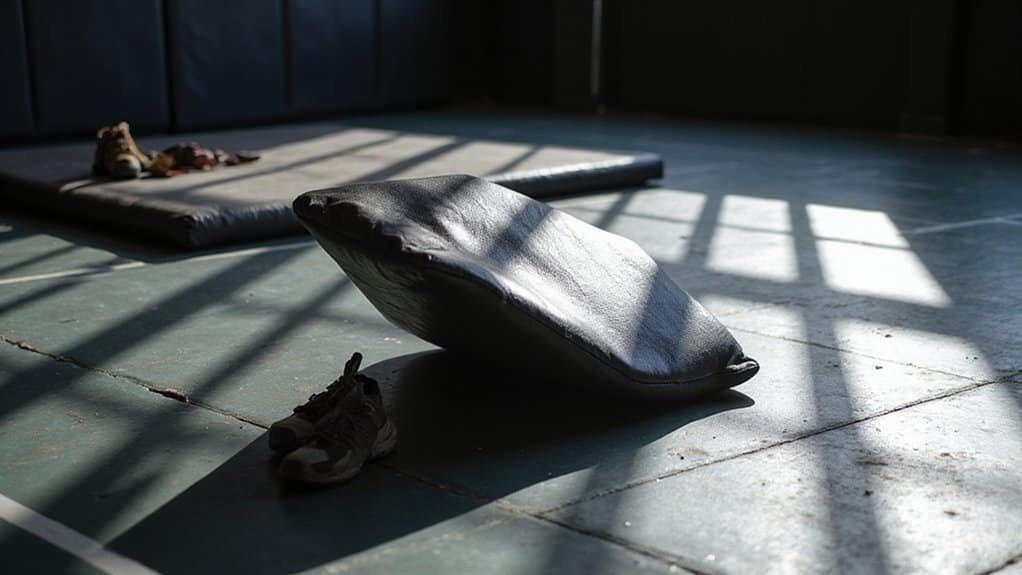Takedowns in MMA involve forcing opponents from a standing position to the ground, fundamentally shifting fight dynamics from striking to grappling exchanges. Fighters employ various techniques, including single-leg, double-leg, and body lock takedowns, each targeting different vulnerabilities in opponent positioning. Strategic timing proves essential, with successful attempts often disguised through feints and level changes. These maneuvers score points under judging criteria while creating opportunities for submissions and ground control. Mastering both offensive and defensive takedown strategies reveals deeper tactical applications.

When two fighters enter the octagon, the battle for positional dominance often begins the moment someone changes levels and shoots for a takedown. This fundamental aspect of mixed martial arts separates the sport from pure striking disciplines, creating opportunities for wrestlers and grapplers to impose their will on opponents who prefer to keep fights standing.
The arsenal of takedown techniques varies markedly in approach and effectiveness. Single-leg takedowns target one leg and work particularly well against fighters maintaining upright stances. Double leg takedowns, considered the highest percentage option from frontal positions, attack both legs simultaneously and provide direct leverage advantages. More dynamic options include suplexes, which rely on body control and lifting techniques, while body lock takedowns focus on controlling the opponent’s torso to set up trips or throws.
Trip takedowns disrupt balance through foot sweeps and are frequently employed during clinch exchanges. Strategic positioning dramatically influences success rates. Mat return takedowns from the back offer higher completion percentages due to reduced defensive resistance. Similarly, attacks from front headlock or chest wrap positions benefit from the opponent’s broken posture. Open position attempts face more defensive obstacles compared to situations where fighters have established secure grips or compromised their opponent’s balance.
Beyond mere technique, takedowns serve multiple tactical purposes within fight strategy. They enable seamless shifts from striking to grappling exchanges while reducing exposure to potential damage. Under MMA judging criteria, successful takedowns provide scoring advantages through demonstrated control and effective positioning. They also create opportunities for submissions and ground-and-pound sequences that can end fights decisively. For wrestlers facing superior strikers, takedowns serve as essential equalizers that neutralize the threat posed by dangerous opponents.
Timing and integration prove vital for success. Effective fighters use feints and level changes to disguise entries while bypassing defensive counters. Takedowns become particularly valuable tools for changing the fight tempo, disrupting the opponent’s rhythm, and recovering from losing striking exchanges. Championship rounds often see an increase in takedown success as fatigue compromises the defensive capabilities of the opponent. Elite fighters continuously develop new techniques to stay ahead of evolving defensive strategies and maintain competitive advantages.
However, modern fighters train extensively to counter these attacks. Successful defense relies on maintaining balance, securing underhooks, sprawling techniques, and lateral movement. Counter-striking with knees and uppercuts punishes telegraphed attempts, while cage positioning provides defensive leverage for wall-walking and returning to standing positions. Mastering the clinch game becomes essential for fighters seeking to control the fight’s progression and dictate the pace of engagement.
The athletic demands remain substantial. Explosive speed, precise timing, and hip strength drive effective entries, while cardiovascular conditioning sustains repeated attempts. Chain wrestling—linking multiple takedown attempts—helps overcome initial resistance and creates sustained pressure that breaks down defensive structures throughout extended exchanges. Most fighters prioritize front engagements since the human body naturally defends against forward-facing threats more effectively than those from behind.
Frequently Asked Questions
How Do I Defend Against Takedowns From Taller Opponents?
Defending takedowns from taller opponents requires controlling distance and disrupting their reach advantage.
Fighters should maintain close inside range or far outside range, avoiding the dangerous mid-range zone. Prioritizing underhooks and collar ties prevents grip establishment, while sprawling with heavy hips counters shooting attempts.
Lateral movement forces stance resets, disrupting timing. Attacking legs and body compromises their base and explosiveness for takedown attempts.
What’s the Best Takedown for Beginners to Learn First?
The double leg takedown stands as the ideal starting point for beginners. Its straightforward mechanics—level change, penetration step, grab behind both knees, drive forward—create high success rates while teaching fundamental grappling concepts like timing and distance management.
The technique’s simplicity reduces exposure to dangerous counters when executed with proper head positioning, forming a solid foundation for advancing to more complex wrestling techniques.
How Much Should I Train Takedowns Versus Striking and Submissions?
Balanced fighters typically allocate equal time across striking, wrestling, and submissions—roughly 25% each, with the remaining quarter dedicated to integrated MMA training.
However, individual weaknesses should dictate adjustments. A striker might emphasize takedown defense and ground skills, while grapplers focus on striking fundamentals.
Quality matters more than strict ratios; live sparring under pressure develops fundamental fight skills better than endless repetition.
Can I Use Wrestling Takedowns Effectively Without a Wrestling Background?
Fighters can effectively use wrestling takedowns without formal wrestling experience through focused MMA training.
Basic techniques, such as single-legs, double-legs, and leg trips, prove accessible to strikers and BJJ practitioners.
Studies show non-wrestlers who secure takedowns win 88% of matches.
Success requires drilling takedown chains, mixing level changes with striking, and emphasizing clinch-based techniques.
Consistent attempts fatigue opponents even when accuracy isn’t elite-level.
What Are Common Injuries From Takedown Training and How to Prevent Them?
Knee injuries are the most significant risks associated with takedown training, accounting for up to 81% of grappling-related injuries.
Strains, sprains, and ACL tears frequently sideline athletes.
Standing throws and wrestling takedowns cause the most damage due to improper technique and fatigue.
Prevention requires structured warm-ups emphasizing mobility, regular strength imbalance assessments, progressive technical instruction, and adequate recovery periods.
Controlled drilling with supervision considerably reduces injury rates during high-intensity practice sessions.

